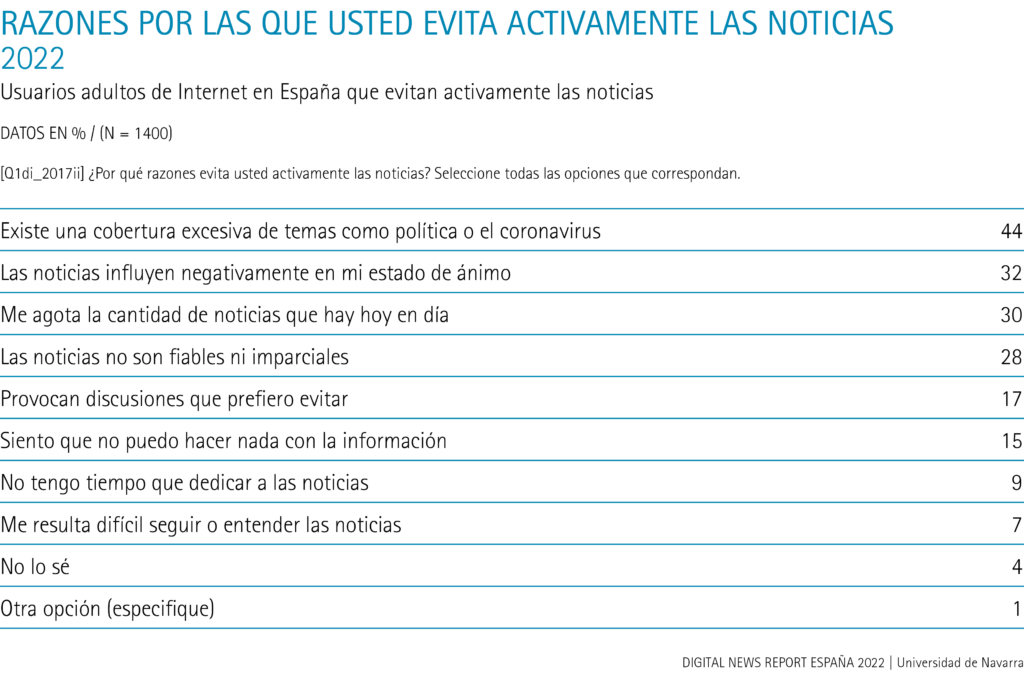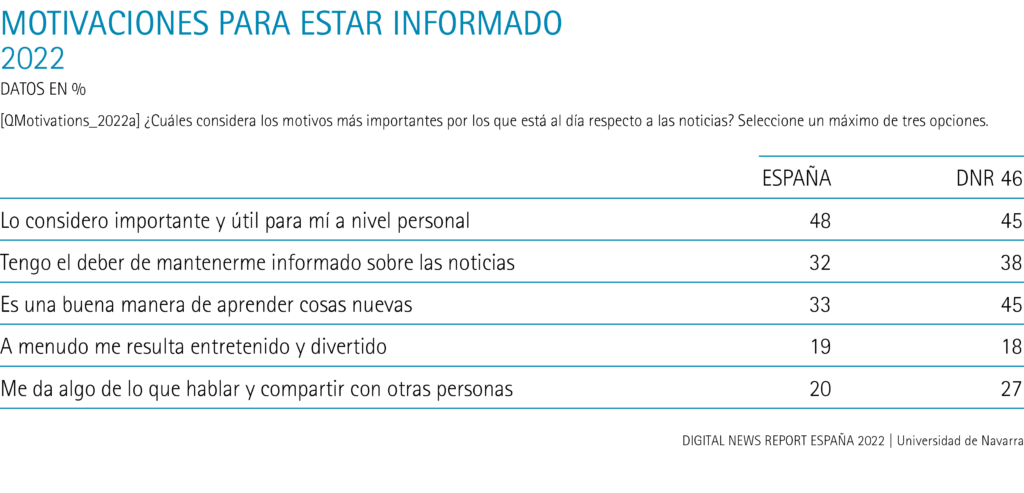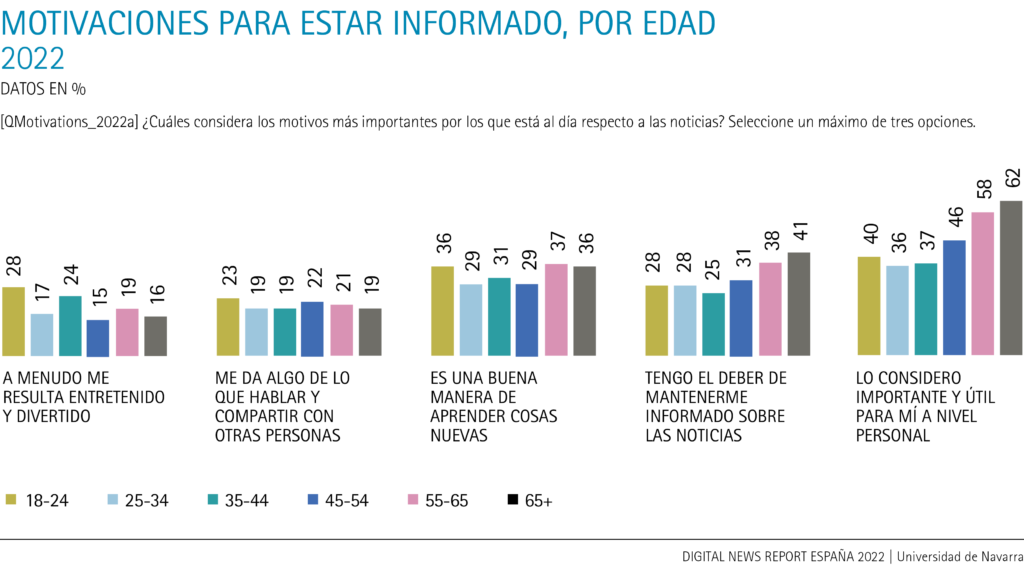-
Excessive coverage of issues, negative influence on mood, fatigue and distrust are the main reasons for avoiding the news.
-
Nearly four out of ten 18-24 year olds perceive information fatigue (I am exhausted by the amount of news available today) (38%), and nearly three out of ten feel they can't do anything with the information (27%).
-
Today's deliberate evasion is positively related to income users leave, of low level educational and who do not know how to situate themselves politically.
Deliberate news avoidance is another issue of concern for news media. The Digital News Report asks Internet users about this issue again in 2022. Seven out of ten respondents say they actively avoid news and do so according to the Degree of 'often/sometimes/occasionally' (69%). In particular, three in ten avoid the news 'often/sometimes' (35%), and one in ten 'often' (10%). On the other hand, almost three out of ten users never avoid news (28%).

The public under 45 years of age is the one that most often, sometimes or at least occasionally avoids information (76%). Specifically, almost eight out of ten young people aged 18 to 24 (78%) and adults aged 35 to 44 (78%). Meanwhile, only one in ten young adults aged 25 to 34 dodge the news 'often' (16%). However, adults aged 55 and older stand out for never skipping the news: almost four in ten of those aged 55 to 64 (37%) and four in ten of those aged 65 and older (39%).
By gender, men are less likely to avoid information: three out of ten never avoid it (30%). This is a 4 percentage point difference compared to women. On the other hand, seven out of ten women reject the news 'often/sometimes/occasionally' (72%). This is 6 percentage points more than men. In addition, almost four in ten women 'often/sometimes' (39%) and one in ten 'often' (12%).
Combining age and gender, women under 45 are the most likely to avoid the news: eight out of ten do so 'often/sometimes/occasionally' (80%). In particular, half of those under 35 years of age avoid them 'often/sometimes' (50%) and almost two out of ten between 25 and 34 years of age reject them 'often' (18%). In contrast to this behavior, four out of ten men aged 65 and over never avoid information (42%).
News avoidance is positively related to low incomes. Nearly eight out of ten respondents with an income of leave resist them according to the Degree of 'often/sometimes/occasionally' (77%). This is 19 percentage points above those on high incomes and 9 points above those on low incomes average. Thus, one in ten Internet users with an income of leave dodges information 'often' (14%). There is a percentage difference of 9 points compared to high-income people and 5 points compared to middle-income people. As a result, four out of ten high-income users never avoid news (40%), three out of ten average (30%) and two out of ten leave (20%).
This correspondence is also verified for the level educational of the respondents. Seven out of ten Internet users with a low educational level ignore the news 'often/sometimes/occasionally' (73%). There is a percentage difference of 7 points with respect to people with a high level educational and 5 points in reference letter to those with a medium level educational . Similarly, one out of ten users with a low educational level 'often' rejects information (12%). This is 5 percentage points more than those with a high educational level. Thus, three out of ten users with a high educational level never avoid news (32%) compared to almost three out of ten with a medium level of education (28%) and two out of ten with a low educational level (25%).
Likewise, the public that claims not to know where they stand politically is the one that avoids the news the most. Seven out of ten of these respondents shy away from information 'often/sometimes/occasionally' (75%). This is 11 points more than those on the right, 6 points more than those in the center and 5 points more than those on the left. In addition, almost half of the users who do not position themselves politically dodge the news 'often/sometimes' (46%), and almost two out of ten do so 'often' (18%). However, as can be seen, respondents on the left (70%) and center (69%) avoid news more than those on the right (64%). Thus, four out of ten of those who declare themselves on the left reject them 'often/sometimes' (39%). This is 12 percentage points above those on the right and 8 points above those in the center. On the other hand, three out of ten users on the right never ignore the news (33%) compared to almost three out of ten on the center (29%) and left (27%).
Finally, and logically, respondents who avoid the news at the level of 'often/sometimes/occasionally' access them less frequently. Seven out of ten access enquiry once a day (74%) and several times a week (75%). However, three out of ten Internet users who never skip news access news several times a day (36%).
Reasons to avoid the news
Information avoidance is related to the excess of news and the fatigue that respondents say they experience, as well as distrust of the news and its unhelpfulness. Four out of ten Internet users consider that there is excessive coverage of topics such as politics or the coronavirus (44%), and three out of ten think that the news negatively influences their mood (32%) and appeal to information fatigue (I am exhausted by the amount of news there is today) (30%). Mistrust (the news is unreliable and unbiased) is also another relevant reason for almost three out of ten users (28%). Other less important causes for shying away from the news are the following: they provoke discussions that I prefer to avoid (17%), I feel I can't do anything with the information (15%), I have no time to devote to the news (9%) and I find it difficult to follow or understand the news (7%).

The under-35 audience stands out for saying that they find it difficult to follow or understand the news (11%). In particular, nearly four in ten 18-24 year olds perceive news fatigue (I am exhausted by the amount of news out there today) (38%), and three in ten feel they can't do anything with the information (27%). Young adults aged 25-34 believe that news has a negative influence on their mood (37%) and provokes discussions that they prefer to avoid (21%). This age group ( group ) also says they have no time to devote to them (12%), as do 18-24 year olds (13%). On the other hand, the 45+ age group stands out for their opinion that there is excessive coverage of topics such as politics or the coronavirus: four out of ten (46%). Specifically, half of adults aged 55 to 64 grade this (52%) and three in ten distrust (news is unreliable and unbiased) (33%). Adults 65 and older also say they can't do anything with the information (23%).
By gender, men avoid the news because of distrust (the news is unreliable and unbiased) (32%), because it provokes discussions that they prefer to avoid (22%) and because of the difficulty of following or understanding the news (9%). Compared to them, this is 7 percentage points more in the first case, 8 points in the second and 4 points in the third. Women, on the other hand, ignore the news because it has a negative influence on their mood (37%). This is a positive difference of 11 percentage points compared to them.
When combining age and gender, women under 35 years of age are the most likely to say that the news has a negative influence on their mood: almost half (47%). This age and gender group also thinks that there is information fatigue (I am exhausted by the amount of news there is nowadays) (36%) and that they lack time to get informed (14%). Information fatigue is also experienced by half of adult women aged 55 to 64, for whom there is excessive coverage of topics such as politics or the coronavirus (51%). For their part, men under 35 feel they can't do anything with the information (23%) and find it difficult to follow or understand the news (17%). Some adults aged 35 to 44 have no time to devote to information (14%), and those over 45 appeal to distrust (news is unreliable and unbiased) (35%). In particular, men aged 55 to 64 note an excess of coverage of topics such as politics or the coronavirus (53%) and that the news provokes discussions that they prefer to avoid (26%).
Information fatigue and distrust are more prevalent among high-income respondents. Three out of ten of these Internet users say they are exhausted by the amount of news available today (35%) and three out of ten believe that the news is unreliable and unbiased (34%). This is 9 percentage points more than those with an income of leave in the first case and 7 points in the second case. News fatigue is also noticed by almost half of the users with average (there is an excessive coverage of topics such as politics or the coronavirus) (47%). In this case, there is a percentage difference of 7 points compared to low-income users. Finally, leave users say that current affairs have a negative influence on their mood (36%). This is 5 points more than the middle and high income groups.
Likewise, information fatigue is linked to respondents with a high level educational who three out of ten claim to be exhausted by the amount of news available today (34%). This is 9 percentage points more than those with a low educational level. In addition, Internet users with a high educational level avoid getting information in order to avoid discussions (22%) and due to lack of time (12%). There is a percentage difference of 8 points compared to people with a low educational level in the first case and 5 points in the second. It is also noteworthy that four out of ten users with a medium level of training state that there is excessive coverage of topics such as politics or the coronavirus (40%).
In any case, there are no significant differences when associating the political inclination of the public and the reasons why they avoid the news. It is only seen that respondents who are on the left show a greater information fatigue (I am exhausted by the amount of news available today) (33%) compared to users who are in the political center (26%). Despite this, almost half of the users in the political center notice that there is excessive coverage of topics such as politics or the coronavirus (47%).
Finally, the three main reasons for the frequency of weekly (and not daily) news access are fatigue, negative effect on mood, and distrust. Half of the respondents who believe that there is excessive coverage of topics such as politics or the coronavirus enquiry the news several times a week (51%). Similarly, nearly four in ten of those who understand that the news negatively influences their mood enquiry it several times a week (37%); and one in three of those who distrust (news is unreliable or unbiased) (34%). This guideline is also followed by one in four who feel they can do nothing with the information (24%).
Reasons to be informed
In addition to asking about reasons for deliberately avoiding the news, this year's survey also asked about reasons for staying informed. Half of Internet users (48%) say they keep up with the news because they 'consider it important and useful at staff'. This is followed by reasons of civic duty as a citizen (33%) and learning new things (33%). Finally, 19% are informed for mere entertainment or to have something to talk to others about (20%).

The analysis by age sample shows that the older age groups are more motivated by the usefulness of the information, by civic duty and by the desire to learn, while the younger ones emphasize the entertaining and amusing nature of the news. There are hardly any differences between ages with respect to social motivation.
